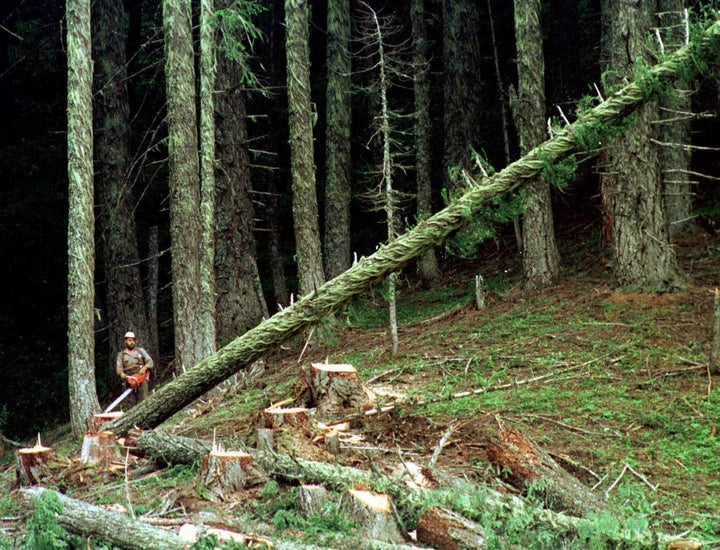Starting in 1933, during the heart of the Great Depression, hundreds of thousands of young, unmarried men went to work for the Civilian Conservation Corps, one of several federal programs created as part of Franklin D. Roosevelt’s New Deal. They built bridges, dams, roads, fire lookouts and other infrastructure.
They also planted trees ― 3 billion of them ― in national forests and throughout the Great Plains to protect farms from Dust Bowl storms. By the time the CCC shuttered in 1943, the wildly popular program, nicknamed “Roosevelt’s Tree Army,” had employed more than 3 million people and vastly improved America’s public lands.
It’s a success story that supporters of the Green New Deal are now looking to as they push for a rapid national mobilization to stave off catastrophic climate change.
Achieving the goals of the Green New Deal will require more than eliminating greenhouse gas emissions from the electricity and building sectors, said Evan Weber, political and policy director of the Sunrise Movement, the climate activist group that stormed Democratic leaders’ offices late last year to push the plan.
“We’ll have to help nature play a big role in making up the difference by absorbing and storing more carbon,” he said in an email.
Weber added that today’s movement can draw inspiration from the CCC and other federally backed job creation programs.
“We must create new programs and policies to protect and restore degraded and threatened ecosystems, and support landowners and farmers to invest in sustainable agricultural and land practices that can also help improve their bottom line,” Weber said.
The Green New Deal, a sweeping resolution unveiled Thursday by Rep. Alexandria Ocasio-Cortez (D-N.Y.) and Sen. Ed Markey (D-Mass.), already has more than 60 Democratic co-sponsors. An early set of guiding principles, it outlines lofty goals of reaching net-zero emissions by 2050, building climate-resilient infrastructure and reversing income inequality by creating high-wage green jobs.
While the document includes few details about how to accomplish these goals, it makes clear that public lands and waters will be key.

The non-binding measure requires “ensuring that public lands, waters, and oceans are protected” and “restoring and protecting threatened, endangered, and fragile ecosystems through locally appropriate and science-based projects that enhance biodiversity and support climate resiliency.” It demands that all U.S. residents are provided with “clean water, clean air, healthy and affordable food, and access to nature.” And instead of relying on emerging technologies to suck greenhouse gases out of the atmosphere, it calls for “restoring natural ecosystems through proven low-tech solutions that increase soil carbon storage,” including large-scale land preservation and planting new forests in treeless areas.
“The success of the Green New Deal is intrinsically linked to how well we can protect and restore our public lands and waters,” Markey told HuffPost in an email Monday. “If we fail, these precious resources will be forever altered. Solutions that include national parks and wild lands will also bring diverse coalitions together and will be critical to the climate mobilization effort.”
It is yet to be seen what sort of public land policy proposals surface as part of this framework. But conservation groups are applauding the measure’s language.
“The resolution recognizes that public lands and waters are a cornerstone of any comprehensive strategy for solving the climate crisis,” Kate Kelly, public lands director at the left-leaning Center for American Progress and a former Interior Department official in the Obama administration, said via email. “It’s pretty simple: we can’t afford to continue to drill away our natural heritage — and we should protect the land and waters that will help protect us from the impacts of climate change.”
A large-scale effort to protect and restore wild spaces would be a grand departure from the last two years, when the Trump administration slashed protections for 2 million acres of national monument land in Utah, offered up millions of federal acres for oil and gas leasing, some of which sold for as little as $1.50 per acre, and prioritized opening Alaska’s fragile Arctic National Wildlife Refuge to fossil fuel development. A press release put out by the Interior Department last week, titled “Energy Revolution Unleashed,” touted a record $1.1 billion in oil and gas lease sales last year.
Approximately one-quarter of all U.S. greenhouse gas emissions come from fossil fuel extraction on federal lands, according to a federal report released by the Trump administration in November.
Weber said it is time the federal government end its practice of leasing lands for fossil fuel production at below market value, and instead explore boosting renewable energy development that helps protect ecosystems, species and indigenous lands.
Just as public lands can be a major driver of climate change, they can also be a tool for combating it.

In a January op-ed in High Country News, Jamie Williams, president of The Wilderness Society, urged backers of the Green New Deal to not forget about public lands in their pursuit of climate action. And Jad Daley, president and CEO of conservation organization American Forests, published an op-ed last week in The Hill in which he writes that “many [Green New Deal] champions are overlooking the huge potential” of forests to reduce planetary-warming emissions and create jobs.
“For a Green New Deal to be the ‘real deal,’ it must embrace forests,” Daley wrote.
At a press conference last week to introduce the resolution, Ocasio-Cortez talked about the importance of environmental protection in fossil fuel-dependent communities like those in Appalachia. But she and Markey did not mention the potential for reducing greenhouse gas emissions through changes in public land management and ecosystem restoration.
“The resolution is silent on any individual technology which can move us toward a solution on this problem,” Markey said at the press conference. “This is a resolution that does not have individual prescriptions in it.”
Ocasio-Cortez’s office did not respond to HuffPost’s requests for comment.
A 2016 study found that humans wiped out 10 percent of Earth’s wilderness areas over just two decades. And a dire report by the United Nations’ Intergovernmental Panel on Climate Change warned that solving the climate crisis will require removing large amounts of carbon dioxide from the atmosphere, in addition to a rapid global effort to scale back fossil fuels. The IPCC examined several pathways to keep the planet’s average temperature from warming 1.5 degrees Celsius (2.7 degrees Fahrenheit) above pre-industrial levels, considered the aspirational goal of the 2015 Paris climate treaty. All pathways required not only stopping deforestation but increasing Earth’s forested areas. And depending on the scale of emissions reductions, the effort could require adding as many as 3.86 million square miles ― an area slightly larger than the U.S. ― of forest by 2050.
“You need to have forestry on your side,” Drew Shindell, a climate science professor at Duke University and a co-author of the IPCC report, told HuffPost at the time.
The Green New Deal is wildly popular among both Republican and Democratic voters, as HuffPost previously reported. Still, Republican lawmakers have been quick to dismiss it as a “top-down” and “impossible” proposal.
The Trump administration’s relentless push for so-called “energy dominance” includes plans to massively expand offshore oil and gas drilling. And an internal document that surfaced last year suggested the National Oceanic and Atmospheric Administration, the nation’s leading ocean science agency, is planning to gut protections for America’s marine national monuments, opening millions of acres of federal water to commercial fishing.
Ocean conservation nonprofit Oceana is among the many groups that celebrated the introduction of the Green New Deal last week. Protecting oceans, as the resolution calls for, is a “no-brainer,” Beth Lowell, the group’s deputy vice president U.S. campaigns, told HuffPost in an email.
“By rebuilding ocean abundance, we can help the coastal communities and fisheries that rely on healthy oceans for generations to come,” she said.
This story has been updated with a comment from Sen. Markey.

